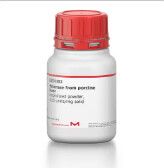Esterase from porcine liver - E3019-3.5ku
$69.77
Sold out
Sold out
Product Details
Esterase from porcine liver - E3019-3.5ku
Application
Esterase from porcine liver has been used in a study to assess the effect of 5-aminolaevulinic acid peptide prodrugs on photosensitization for photodynamic therapy. Esterase from porcine liver has also been used in a study to investigate how site-specific atherogenic gene expression correlates with subsequent variable lesion development in coronary and peripheral vasculature.
The enzyme from Sigma has been immobilised in hollow fibre ultrafiltration membrane and used for the asymmetric hydrolysis of a meso-diester.[1] Esterase from Sigma has been used to investigate its effect on the release of methacrylic acid (MAA) and 2-hydroxyethyl methacrylate (HEMA) from adhesives formulated under conditions simulating wet bonding.[2] It has been used to examine the ability of carboxylesterase activity to remove permethrin- and bifenthrin-associated toxicity to Ceriodaphnia dubia and Hyalella azteca in a variety of matrices.[3]
Porcine liver esterase is used to catalyze the hydrolysis of pentaacetyl catechin and epicatechin for use in pharmaceutical and industrial applications.
Pig liver esterase is commonly used for kinetic resolutions and assymetric synthesis in organic chemistry.
Pig liver esterase is commonly used for kinetic resolutions and assymetric synthesis in organic chemistry.
Packaging
3500, 20000, 100000, 500000 units
Biochem/physiol Actions
Esterase acts on water-soluble carboxyl esters containing short chain fatty acids. Its functionality is attributed to the catalytic triad of Ser, His and Asp/Glu.
Pig liver esterase catalyzes enantioselective conversion of an ester to a carboxylic acid. The molecular weight is found to be 168 kDa. It is a serine enzyme with two active sites on each molecule, which dissociates into active half-molecules in the presence of dilute acid or concentrated salts.[4]
Unit Definition
One unit will hydrolyze 1.0 μmole of ethyl butyrate to butyric acid and ethanol per min at pH 8.0 at 25 °C.
Save this product for later
Esterase from porcine liver - E3019-3.5ku
Display prices in:USD

